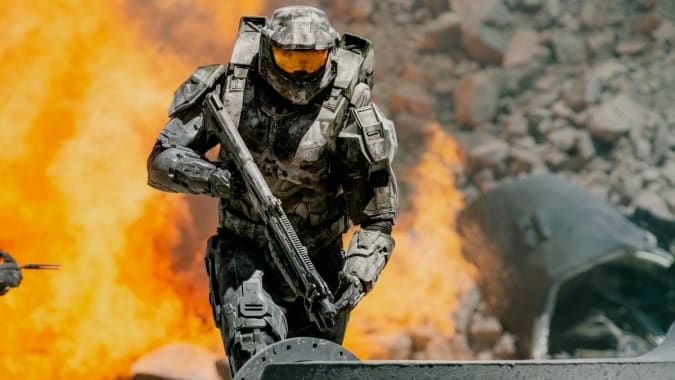Halo’s TV adaptation doesn’t waste any time differentiating itself from the popular game franchise. We open in a rebel village bar, where patrons are discussing the evil UNSC (United Nations Space Command) and boogey-man like Spartans. It could easily be a scene from Firefly, the short-lived series about plucky folks fighting for freedom against an authoritarian central government. In short order, a group of Covenant aliens attack, leading to a bloody massacre where limbs are blown off, skulls take serious damage and an entire room of children is murdered. It’s not too long before Master Chief (Pablo Schreiber), our hero clad in glorious green armor, appears and wipes out the alien threat with a unit of super-human Spartan soldiers with brutal yet elegant efficiency.
Spoilers ahead for Halo on Paramount+.
The core Halo games were always rated M for Mature by the ESRB, but they never felt as gory as the Paramount+ show’s opening. When you’re playing as Master Chief, you feel like a one-man army going on a fun intergalactic adventure. The TV series instead begins by focusing on people usually ignored by the games. Only one survivor is left from that rebel village, a teenaged girl named Kwan Ah. But instead of being cared for by the Spartans and their UNSC and United Earth Government overseers, she’s treated as a prisoner. While the Halo games have typically treated the UEG as a sort of benevolent authoritarian regime, the show frames the military government as controlling and villainous.
That may end up turning off the franchise’s most diehard fans, but it’s a more honest representation of what the UNSC represents. Master Chief quickly learns that he can’t trust his leaders either. After touching an alien artifact, he begins to have flashbacks to a former, pre-soldier life. While the show isn’t quick to jump into his origins, Halo fans know the history of the Spartan soldiers is rife with controversy. Master Chief, and other members of his cohort, were actually kidnapped as children, genetically modified and trained to be battle-hardened super soldiers. While the games rarely wrestled with the horrors and complexity of that program, the lore-heavy Halo novels filled in the gaps.

Paramount+
What’s most interesting about the Halo series is that it’s confronting that backstory head-on. When we first meet Master Chief, he’s the ultimate soldier we’re familiar with. But when the UNSC orders him to kill Kwan Ah, he hesitates and does something we’ve never seen in the games: He takes off his helmet. Instead of killing the defenseless teen, Master Chief goes rogue. The super soldier starts to think for himself.
Unfortunately, the interesting elements of Halo are somewhat outweighed by the show’s simplistic writing, stiff acting and sometimes dodgy special effects. If it came out in 2015, when we first expected it to arrive on Showtime, it would be more impressive. But now we’re practically living through a golden age of sci-fi TV. The Mandalorian (and to a lesser extent, The Book of Boba Fett), is giving us several episodes of big-budget Star Wars action annually! Foundation on Apple TV+ isn’t the Asimov story as we know it, but it looks incredible. The Expanse skillfully brought an epic book series to life. And even Ridley Scott is dabbling in science fiction again with Raised by Wolves.
It also doesn’t help that, at its core, Halo feels like a retread of The Mandalorian’s riff on Lone Wolf and the Cub in space. Kwan Ah isn’t a child, but she’s a defenseless innocent who’s being protected by a tough-guy space loner who’s forced to go against his superiors. Whatever made Halo seem unique several years ago just doesn’t exist anymore.